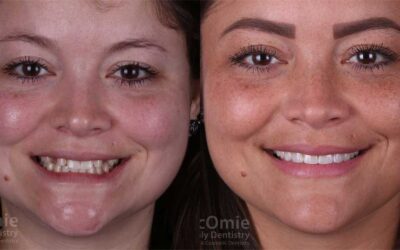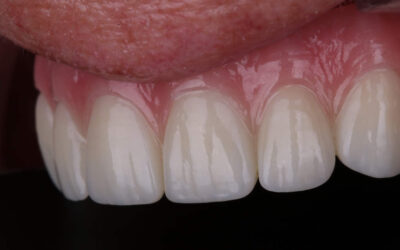WE OFTEN TAKE STEPS to achieve that sparkling white smile when we brush in the morning and before we go to bed. The truth is, what we consume throughout the day is often the largest contributor to whether or not our smile will light up a room.
Although there are several causes for tooth discoloration, we can separate them into three basic categories: intrinsic, extrinsic, and age-related discoloration. Here’s how each affects your teeth, and what you can do to ensure a life full of bright, healthy smiles.
Food And Drink Are Large Contributors To Surface Stains
Extrinsic tooth discoloration occurs when the enamel—the outer layer of the tooth—becomes stained. These stains are caused by pigments, acidic content, and other chemical factors (natural or artificial) present in things we enjoy eating and drinking.
A few common culprits for tooth discoloration include:
- Wine
- Coffee
- Smoking
- Spit tobacco dip, chew, etc.
- Tea both sweet and un-sweet
- Cola
- Sports drinks
- Hard Candy Especially Sour Candy
- Berries
- Tomato Sauce
In our experience at McOmie Family Dentistry, we see most of the stain comes from coffee and tobacco. The perfect formula to stain a tooth is to drink lots of coffee and smoke. The coffee has stain properties as does the smoke. When you combine these two you bake the stain on with hot smoke. Avoid doing this!
Most of these items won’t have an immediate effect on the color of your teeth, but over time, they can begin to wear away and cling to enamel causing unsightly stains. Try to consume these in moderation and always remember to drink plenty of water and brush your teeth after meals. Here in the south Sweet Tea is a way of life, you can drink it, but it would be very helpful if water was drunk after the sweet tea. This can rinse away the sugar and the stain-causing tea. Plus drinking water is the healthiest!
Here’s a couple of quick tips to help avoid those wine stains!
Trauma Can Discolor Teeth From The Inside Out
Intrinsic tooth discoloration occurs when the inner structure of the tooth—the dentin—begins to darken or develop a yellow tint. This type of discoloration can develop because of a trauma sustained to the tooth. Sometimes when a tooth sustains trauma during childhood, it can damage the developing permanent tooth beneath it, affecting the tooths color. If a trauma is sustained during adulthood, internal bleeding can potentially discolor the damaged tooth.
Other causes include use of medication at certain stages of life or being born with a rare condition called dentinogenesis imperfect which can cause gray, amber, or purple discolorations. If you have questions about intrinsic discoloration, come in and see us and we can help answer your questions. These days Tetracycline stain doesn’t occur because the medical profession has a good understanding about not using the antibiotic when the teeth are developing. If you are between the ages of about 45 and 65 then you more than likely know people with stained teeth from Tetracycline.
A question we recently got:
Q. My 9-year-old son has been diagnosed with possible Lyme disease. Our physician wants him to take doxycycline for 14 days. Don’t antibiotics stain teeth?
A. Doxycycline is a tetracycline antibiotic. Tetracyclines all bond to ions of magnesium, aluminum, and calcium, which are all present in the formation of teeth as we are developing. The Infectious Disease Society of America recommends doxycycline to treat Lyme disease in people over the age of 8. In a 9-year-old, the central, lateral incisors and first molars (some of the permanent teeth) have erupted.
They have a layer of primary dentin and will continue to form secondary dentin as the child grows. The tetracycline antibiotics are incorporated into the secondary dentin, but staining is minimal in these teeth due to the short duration of the therapy and the buffering layer of primary dentin – meaning that the staining will be on the very innermost part of the tooth. Post-eruption staining has been reported in adolescents and adults; however, the duration of treatment is longer than 10 days. So yes, there is going to be some staining of the tooth. Although with only 14 days duration, it will be minimal. There is a section of our population that was born from the late ‘50s to the early ‘70s that were exposed to large amounts of tetracycline for years as children and have banded layers of stain on their teeth as a result. This practice has been discontinued.
Your Smile Can Change Color With Age
Age-related tooth discoloration is a combination of both intrinsic and extrinsic factors. The dentin inside our teeth naturally yellows as we age. Enamel on the outside of teeth also thins as we get older, allowing the yellow pigment of the dentin to show through. A lifetime of consuming certain foods or smoking cigarettes will also contribute to deep-set stains on the enamel’s surface.
We Can Help Brighten Your Smile
We know just how important it is to provide our patients with bright, healthy smiles. Each situation is unique and we provide our patients with effective solutions for their unique oral health needs. If you have any questions about your smile’s appearance, let us know in the comments below or call and make an appointment today! McOmie Family Dentistry 423-899-1112.
The greatest thing is we can reverse staining here in the office. Yes, this is true! We have multiple teeth whitening systems that have a price range from $200-$800 dollars all are effective! We can do internal bleaching if you have a tooth with a root canal that has become discolored. Just call and come in for a FREE consultation. Let’s get those teeth white and keep them white. We know-how and can help you achieve your goals!
Watch this video for some tips on whitening your teeth! Both at-home whitening and in-office whitening!




